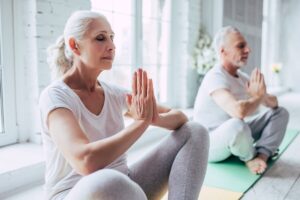Every person experiences feelings of stress or anxiety at some point in their life. Whether the stressor is temporary and passes quickly or long-term and ongoing, there are proven methods available to us all that can alleviate the feeling.
Many of these techniques require neither expensive equipment nor money to use effectively, yet many include physical activity (like jogging) while others focus on shifting your mindset.
Progressive Muscle Relaxation
Progressive Mus Relaxation (PMR) is an easy and effective technique that can help ease tightness in the body while decreasing emotional stress levels and helping with sleep quality. By repeatedly tensing and relaxing muscle groups in an orderly fashion, PMR allows individuals to become familiar with what tension feels like in their own bodies so they can respond faster at signs of anxiety.
Goal of Stretch & Release Exercise is to tense each muscle group for 10 seconds before relaxing it for about that same length of time. Start at the top of your body and work downward or vice versa.
Therapists sometimes suggest saying, “RELAX!” while you release each muscle group to reinforce the message of relaxation. A diary can be helpful in tracking progress and finding ways to enhance relaxation techniques.
Studies have demonstrated the efficacy of relaxation training techniques such as deep breathing, PMR, and guided imagery in creating psychological and physiological relaxation. For example, one study involved sixty healthy undergraduate participants participating in 20 minutes of either deep breathing training, PMR training or guided imagery training – these were then measured prior, during, and post training session to determine which produced greater relaxation effects; PMR and guided imagery training groups experienced linear trends towards relaxation while deep breathing participants demonstrated a curvilinear increase in physiological arousal before returning back down towards baseline levels after 20 minutes of training session before returning home for further assessments before continuing further analysis.
Breathing Exercises
Breathing exercises are an easy, straightforward way to reduce anxiety and alleviate stress. They can be used alone or alongside other relaxation techniques; the key is finding one that suits you and practising at least 3-5 times each day until results show. Integrate it into daily tasks, such as before brushing teeth or first thing in the morning; set an alert on your phone or place a reminder somewhere visible so as to remember to perform this breathing exercise!
As soon as your body senses a threat, its natural response is to activate its “fight or flight” response, prompting your heart to beat faster and breathing rate to increase. Although these reactions are important in protecting us against danger, overdoing it may result in high blood pressure, as well as other serious health conditions. Regularly practicing breathing exercises may reduce both heart rate and breathing rate while improving lung function.
Studies demonstrate the power of breathing exercises to increase feelings of calmness and reduce anxiety. They can be practiced by adults and children of all ages without needing special equipment – they’re perfect for use before, during, and after stressful events; plus they could also benefit those suffering from anxiety disorders and sleep issues.
Yoga
Yoga is a holistic mind-body practice that integrates stretching, flexibility training, strength training, meditation and relaxation techniques into one holistic system. Research has demonstrated the many physical and psychological benefits of practicing Yoga; strength is increased while muscle tone decreases. Yoga also helps reduce anxiety symptoms by relaxing muscles and learning to control emotions more effectively; in addition, endorphins release naturally that provide relief from stress.
Researchers have demonstrated that a 12-week yoga intervention significantly reduces self-reported levels of stress for both healthy participants and those experiencing chronic health conditions such as hypertension, cancer, headaches or arthritis (Domingues 2018). Additional research has investigated how yoga could possibly influence stress – through mechanisms like increased mindfulness, interoceptive awareness spiritual wellbeing or self-compassion (Domingues, 2018).
Though all these psychosocial mechanisms may have some bearing on stress levels, interoceptive awareness has been studied extensively as one such potential stress-reducing measure. Interoceptive awareness refers to enhanced body awareness and enhanced capability of monitoring bodily sensations and emotions more precisely. Studies have also demonstrated the direct effects of mindfulness and self-compassion on psychologically perceived stress levels, while posture and breathwork appear to regulate only physiological arousal levels. These differences could suggest that future research comparing different yoga interventions designed for either physical or psychological stress may shed more light on why certain programs appear to be more directly effective at alleviating certain kinds of strain.
Meditation
Meditation can be an effective way to manage stressful or anxious thoughts, such as the Mindfulness-Based Stress Reduction (MBSR) program which has been shown to significantly decrease both anxiety and depression symptoms.
At this type of meditation, the focus is on body and breath. Your goal should be to relax and release tension; one way of doing this may be noticing how each inhale and exhale affects how your body feels; then when your thoughts wander off-course simply return back to body and breathing.
Meditation helps you recognize and observe your feelings without trying to control or judge them. Labelling feelings may provide some perspective and shed light on what’s happening, helping you uncover potential underlying causes for anxious symptoms.
At times, repetitive thoughts or ruminations can become an anxiety trigger. Through meditation, however, you can learn to observe them without joining these “thought trains.” Over time this allows you to gain some distance from anxiety-inducing thoughts and emotions – lessening their impact.
Meditation alone cannot treat anxiety; for maximum benefits it should be combined with other coping tools and medication. But meditation may provide one effective coping tool in addition to therapy sessions and medications.




